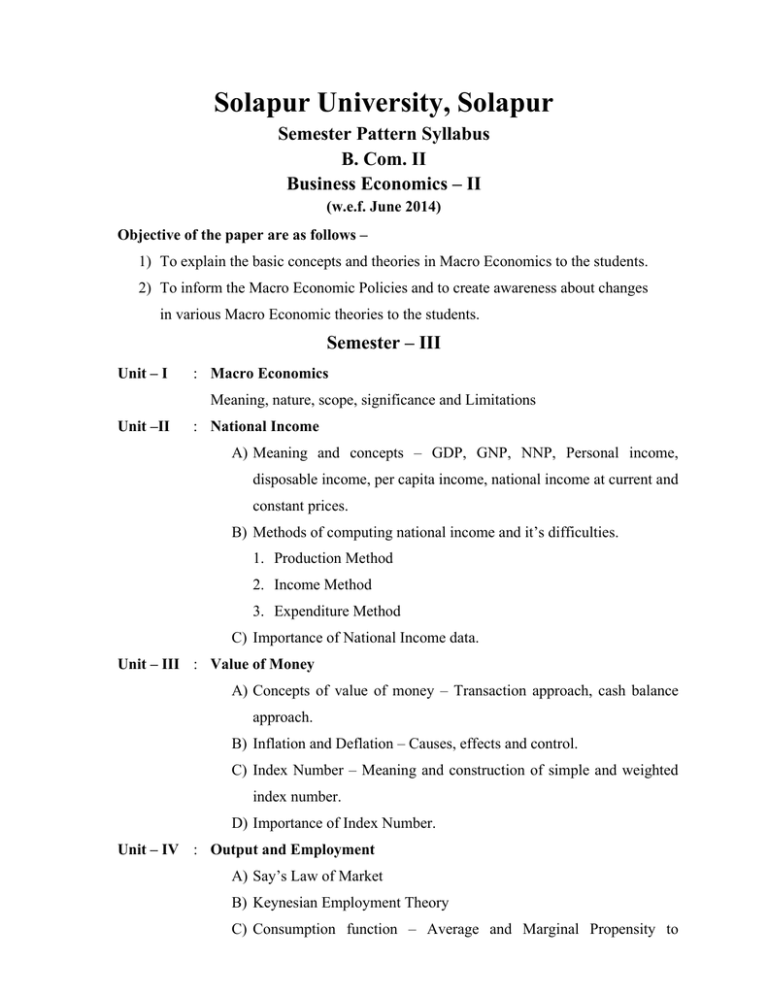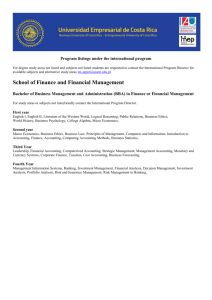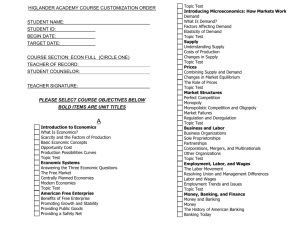Solapur University, Solapur Semester Pattern Syllabus B. Com. II Business Economics – II
advertisement

Solapur University, Solapur
Semester Pattern Syllabus
B. Com. II
Business Economics – II
(w.e.f. June 2014)
Objective of the paper are as follows –
1) To explain the basic concepts and theories in Macro Economics to the students.
2) To inform the Macro Economic Policies and to create awareness about changes
in various Macro Economic theories to the students.
Semester – III
Unit – I
: Macro Economics
Meaning, nature, scope, significance and Limitations
Unit –II
: National Income
A) Meaning and concepts – GDP, GNP, NNP, Personal income,
disposable income, per capita income, national income at current and
constant prices.
B) Methods of computing national income and it’s difficulties.
1. Production Method
2. Income Method
3. Expenditure Method
C) Importance of National Income data.
Unit – III : Value of Money
A) Concepts of value of money – Transaction approach, cash balance
approach.
B) Inflation and Deflation – Causes, effects and control.
C) Index Number – Meaning and construction of simple and weighted
index number.
D) Importance of Index Number.
Unit – IV : Output and Employment
A) Say’s Law of Market
B) Keynesian Employment Theory
C) Consumption function – Average and Marginal Propensity to
consume – factors influencing consumption function.
D) The investment multiplier.
E) Investment function – Marginal efficiency of capital and its
importance.
Semester – IV
Unit – I
: Business Cycles
A) Meaning and phases
B) Theories of business cycles – Hawtrey and Schumpter
Unit – II
: Public Finance
A) Meaning, nature and Scope of Public Finance – The Principle of
maximum social advantage.
B) Direct and indirect taxes – Meaning, merits and demerits, concept of
value Added Tax (VAT) and its importance.
C) Public expenditure – Causes of growth in public expenditure, effects
of public expenditure
D) Public debt – Kinds of public debt, causes and effects of public debt.
E) Public budget – Meaning and kinds of budgets.
Unit – III : International Trade
A) Meaning of internal and international trade.
B) Advantages and disadvantages of international trade.
C) Theories of International Trade – Ricardian theory and Heckscher –
Ohlin theory.
D) Terms of Trade.
E) Balance of Payments – Disequilibrium – Causes and remedies.
Unit – IV : Foreign Exchange
A) Exchange rate – fixed, floating and spot.
B) Purchasing power Pariety theory.
Reference Books:
1)
Monetory Theory – Vaisha M.C.
2)
Principles of Economics – Agarwal H.S.
3)
Advanced Economic Theory – Jhingan M.L.
4)
Economics – Benkam
5)
Theory of International Trade – Haberler
6)
Economics of J.M. Keynes – Dillard Dudley.
7)
Economics, 114 Ed by P.A. Samuelson and William D. Nordhan
(Mc Graw Hill International)
8)
An Introduction of positive Economics – R.G. Lipsey and K.A.
Criyatal (8th Ed.) ELBS, Oxford University Press.
9)
Monetory Theory K.K. Dewett
10) Modern Economics Theroy – D.M. Mithani
11) g_J«bjr AW©emó - S>m°. ^mboamd
12) g_J«bjr AW©emó - XogmB©, Omoer
(Dr. D.R. Baad)
Solapur University, Solapur
Semester Pattern Syllabus
B. Com. II
Money and Financial System
(w.e.f. June 2014)
Semester – III
Unit – I
: Money
Meaning and definition of Money, Types of Money, Functions &
Constituents of Money supply in India. (M1, M2, M3, M4) high powered
Money – meaning - uses and sources of changes in high powered money.
Unit – II
: Money Market in India
Concept of money market – nature of money market – features of money
market, Role of money market in economic development, organized money
market – call money market – unorganized money market – hawala market.
Unit – III : Monetary Policy
Meaning – objectives of monetary policy – instruments of monetary policy
application of monetary policy in inflation and recession – monetary policy
and economic development – limitation of monetary policy.
Unit – IV : Finance in India
Role of finance in economy – Kinds of finance – financial system –
components, financial intermediaries – banking and non-banking financial
Institutions.
Semester – IV
Unit – I
: Banking – Meaning – Definitions and Functions
a) Primary functions.
b) Secondary functions.
c) Other functions/ miscellaneous function or utility services.
Unit – II
: Opening & Operating Banking Accounts
a) Opening &operating Banking Accounts – Procedure for opening
account – know your customer (KYC) norms – Application Form –
Introduction – Proof of residence – Specimen Signature and
nomination – their importance – No frills account.
b) Operating Deposit Accounts – Pay-in-slips – withdrawal slip –
passbook – cheque book – F.D. Receipt – Premature encashment of
fixed deposit and loan against fixed deposit – Recurring deposit.
c) Transfer of account – closure of accounts –
d) Types of account holders.
e) Methods of remittance – Demand Drafts, Banker’s Cheque,
Electronic Transfer (Real Time Gross Settlement [RTGS]) National
Electronic Fund Transfer (NEFT)
Unit – III : Credit Money & Lending Principles
a) Credit money & Credit creation – Process and limitations.
b) Lending Principles – Safety, liquidity, Profitability diversification of
risks – balancing of profitability and liquidity – priority lending’s.
Unit – IV : Technology in Banking
Need and importance of technology in Banking – ATM – Credit Card –
Debit Card – Tele Banking – Net Banking – SWIFT (Society for worldwide
interbank Financial Tele Communication) Concept of core banking.
Reference Books
1)
Sayers – Modern Banking.
2)
Banking Law and Practice in India – Tannans.
3)
Banking Theory and Practice – K.C. Shekhar
4)
Modern Banking – M.C. Vaish.
5)
Money Banking International Trade & Public Finance – Mithani
D.M.
6)
Banking – Theory, Law & Practice – Lordon, Natarajan.
7)
~±qH$JMr VÎdo Am{U ~±qH$J nÕVr - S>m°.
Hw$ê$bH$a
8)
A{YH$mof Am{U ZmUo~mOma - lr. Am. Xoenm§S>o
9)
~±qH$JMo \$m`Xo d ì`dhmanÕVr - d¡Ú ^m.h.
10) Current Banking Theory & Practice – S.K. Basu.





